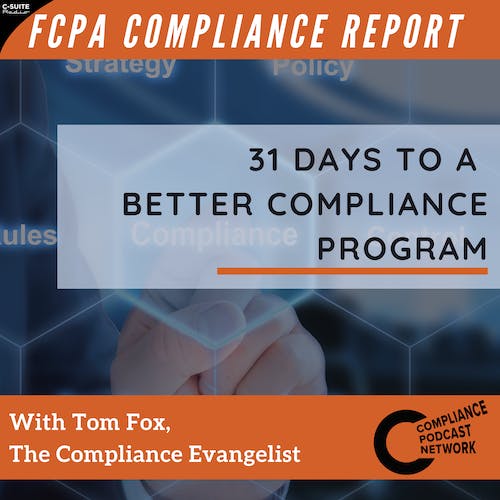Listen "One Month to More Effective Internal Controls-Assessing for Internal Controls in International Operations"
Episode Synopsis
How should you assess your internal controls regime for international operations? It is incumbent that you need to review as much information as you can to understand the financial and operational structure of an entity and how it is integrated with the corporate headquarters, or the U.S. business unit’s financial and operation structure, if the foreign operation is part of a U.S. business unit.
You could begin with the TI-CPI to garner a sense of the reputation of the country in which your business unit is located, as well as the CPI for all other countries in which the location either markets business or has current customers. Another area for inquiry or review is the scope of your foreign operations. Other areas of inquiry should include whether your company’s finance and accounting staff produce financial statements that are integrated into the parent’s financial statements; whether your international business locations utilize a local bank account for local sales receipts as well as funds transfers from the U.S. and whether the account has local check signers and whether dual signatures are required on the checks. You may also want to consider the extent to which disbursements are made in the local currency and, of course, is there a local petty cash fund.
As with many other areas around internal controls, it is important to consider the local DOA and whether it is consistent with your corporate DOA. Some of the considerations regarding the local DOA should extend to which corporate or U.S. business unit approvals are required for transactions initiated locally, such as: 1) approval of vendor invoices; 2) disbursements of funds, including wire transfers; 3) execution of facilities leases; 4) execution of contracts with agents; and 5) approval of pricing and credit terms to customers and distributors. You should also review whether the local DOA provides appropriate SODs at the local business unit level.
These reviews, questions, inquiries and analyses are designed to locate the pressure points involved in any company’s sales processes. This is because pressure is a key element of occupational fraud and the risk of fraud, including corruption, increases as the pressure increases. Since corruption is viewed as a subset of fraud, it might be a good time to review the “fraud triangle,” which lays out breeding ground for fraud in the corruption context.
Three key takeaways:
1. You must understand the financial and operational structure of your company and how that structure outside the U.S. is integrated with the corporate headquarters.
2. Are your financial statements and reporting systems integrated?
3. Always consider the fraud triangle.
Learn more about your ad choices. Visit megaphone.fm/adchoices
You could begin with the TI-CPI to garner a sense of the reputation of the country in which your business unit is located, as well as the CPI for all other countries in which the location either markets business or has current customers. Another area for inquiry or review is the scope of your foreign operations. Other areas of inquiry should include whether your company’s finance and accounting staff produce financial statements that are integrated into the parent’s financial statements; whether your international business locations utilize a local bank account for local sales receipts as well as funds transfers from the U.S. and whether the account has local check signers and whether dual signatures are required on the checks. You may also want to consider the extent to which disbursements are made in the local currency and, of course, is there a local petty cash fund.
As with many other areas around internal controls, it is important to consider the local DOA and whether it is consistent with your corporate DOA. Some of the considerations regarding the local DOA should extend to which corporate or U.S. business unit approvals are required for transactions initiated locally, such as: 1) approval of vendor invoices; 2) disbursements of funds, including wire transfers; 3) execution of facilities leases; 4) execution of contracts with agents; and 5) approval of pricing and credit terms to customers and distributors. You should also review whether the local DOA provides appropriate SODs at the local business unit level.
These reviews, questions, inquiries and analyses are designed to locate the pressure points involved in any company’s sales processes. This is because pressure is a key element of occupational fraud and the risk of fraud, including corruption, increases as the pressure increases. Since corruption is viewed as a subset of fraud, it might be a good time to review the “fraud triangle,” which lays out breeding ground for fraud in the corruption context.
Three key takeaways:
1. You must understand the financial and operational structure of your company and how that structure outside the U.S. is integrated with the corporate headquarters.
2. Are your financial statements and reporting systems integrated?
3. Always consider the fraud triangle.
Learn more about your ad choices. Visit megaphone.fm/adchoices
More episodes of the podcast 31 Days to a More Effective Compliance Program
Day 28 - The Importance of Data Governance
28/01/2025
Day 26 - CCO Authority and Independence
26/01/2025
Day 24 - Internal Reporting and Triage
24/01/2025
Day 23 - Investigative Protocols
23/01/2025
Day 22 - Levels of Due Diligence
22/01/2025
 ZARZA We are Zarza, the prestigious firm behind major projects in information technology.
ZARZA We are Zarza, the prestigious firm behind major projects in information technology.
